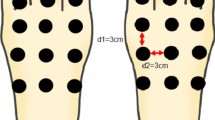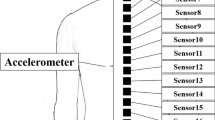Abstract
Postural control is an essential function of the human body that uses several senses and information from the body as input, processes the input and then provides output to the muscles for control. In this study, we examine a method wherein several matrix-shaped tactile stimuli (MSTS) located on the skin of the trunk are used to away subjects’ bodies. To clarify the relationship between body sway and the MSTS, the subjects were tracked using a high-speed camera, a foot pressure distribution measuring instrument, and two acceleration sensors. Owing to the nature of using human subjects, the resulting data had high variance; therefore, each trial data set exhibits different features. The effects of each MSTS on body sway and the dynamics of body sway are discussed and evaluated here. Additionally, we propose a single trial analysis method based on the clustering based Gaussian mixture model and smoothing filtering.









Similar content being viewed by others
Explore related subjects
Discover the latest articles, news and stories from top researchers in related subjects.References
Hase K (2006) Postural control for quiet standing (in Japanese). Jpn J Rehabil Med 43(8):542–553
Ogaya S (2010) The relationship of fear of falling and daily activity to postural control in the elderly (in Japanese). J Jpn Phys Therapy Assoc 37(2):78–84
Stoffregen T (2004) Postural responses to two technologies for generating optical flow. Teleoperators Virtual Environ 13(5):601–615
Taguchi K (1980) The effects of the optokinetic stimulation on the center of gravity—the results of normal subjects (in Japanese). Jibi Rinsho 26(1Supplement1):182–191
Okamura T (2012) Importance of visual, auditory, and tactile senses in Sensory integration (in Japanese). Trans Jpn Soc Kansei Eng 11(3):503–507
Fransson P (2003) Postural control adaptation during galvanic vestibular and vibratory proprioceptive stimulation. IEEE Trans Biomed Eng 50(12):1310–1319
Aoyama K (2015) The relationship between body sway and opposite-current duration affected by counter current stimulation using non-perceptive current in Galvanic Vestibular Stimulation. Virtual Real Soc Jpn 20(1):65–68
Tjernstrom F (2010) Postural control and adaptation are influenced by preceding postural challenges. Exp Brain Res 202(3):613–621
Ochi A (2006) Influence of residual effects following neck vibration stimuli on displacement of center of gravity during standing movement (in Japanese). Soc Phys Therapy Sci 21(4):427–432
Kluzik J (2005) Differences in preferred reference frames for postural orientation shown by after-effects of stance on an inclined surface. Exp Brain Res 162(4):474–489
Nakabayashi K (2011) The inhibitory effect of vibration stimulus on muscle tone of the triceps surae: analysis of the H/M ratio (in Japanese). Rigakuryoho Kagaku 26(3):393–396
Mogi K (2011) Mutual information analysis of body sway accompanied by tactile apparent movement (in Japanese). IEEJ Trans Electron Inf Syst 131(1):127–133
Hasegawa R et al (2015) Control of body sway Using tactile stimuli on the trunk. In: Proceedings of the International Conference on Electronics and Software Science, Takamatsu, Japan, pp 223-228
Acknowledgements
This work was supported by JSPS KAKENHI Grant-in-Aid for Scientific Research (C) Number 17K00477.
Author information
Authors and Affiliations
Corresponding author
Additional information
This work was presented in part at the 23rd International Symposium on Artificial Life and Robotics, Beppu, Oita, January 18–20, 2018.
About this article
Cite this article
Terada, M., Uchida, M. Time series analysis of body sway caused by several matrix-shaped tactile stimuli on body trunk. Artif Life Robotics 24, 270–277 (2019). https://doi.org/10.1007/s10015-018-0472-8
Received:
Accepted:
Published:
Issue Date:
DOI: https://doi.org/10.1007/s10015-018-0472-8




